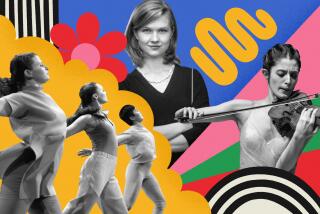MUSIC REVIEW : Electronic Sounds Echo Quieter Era
SAN DIEGO â The prevalence of pulsating car alarms, bleating telephones and assorted beepers has made electronically produced sounds irritatingly familiar. But Thursdayâs concert of electroacoustic music at the University of San Diego brought back a quieter era when electronic sounds were both novel and amusing.
As part of the College Music Societyâs annual conference, the noon program at Shiley Theatre offered a retrospective of shorter electronic works from 1952-1972. All were recorded on tape, although two pieces required the participation of a live performer. Hence the ungainly adjective âelectroacoustic.â
Saluting the first U.S. performance of electronic music in New York on Oct. 28, 1952, Thursdayâs program opened with three offerings that had been premiered on that historic occasion 40 years ago. Their charming naivete and close proximity to the sound sources that they manipulated--primarily piano and flute--set them apart from the highly abstract montages that later defined the genre.
Otto Lueningâs âFantasy in Space,â which he made by overdubbing his own flute performance, created an impressionistic echo chamber of pastoral sounds. The dapper nonagenarian was present to accept the audienceâs applause for âFantasy in Spaceâ and for âIncantation,â a sonic sampler that Luening and Vladimir Ussachevsky created together. Ussachevskyâs âSonic Contoursâ sounded only slightly more distorted than an ancient Edison cylinder recording of a piano performance.
Humor reared its welcome head with Jon Appletonâs âChef dâOeuvre,â an electronic manipulation of a singing commercial for Chef Boy-ar-dee pizza that was issued as a 45 r.p.m. record and made the pop charts in 1969. Recognizable snippets of the Andrews Singersâ silly commercial popped in and out of a snappy electronic maze. âNewark Airport Rock,â Appletonâs flip side of âChef dâOeuvre,â spliced random comments about electronic music over a generic rock drum track to achieve an amusing commentary about the genre. Appleton, who was also at the concert, made the piece from opinions from travelers stranded at an airport.
On the serious side, Milton Babbittâs 1961 âVision and Prayerâ sheathed the Dylan Thomas 12-stanza poem with garlands of beeps and bell sounds. Soprano Mimmi Fulmer successfully navigated the treacherous vocal line, which ranged from deadpan Sprechstimme to angular, full-voiced singing. Contrabassist Bertram Turetzky gave a passionate account of Robert Ericksonâs 1967 Ricercar a 3, which the composer wrote for Turetzky. Ericksonâs crafty, rumbling counterpoint--two recorded and manipulated bass lines played against a live bass solo--displayed the rigor of a Baroque fugue and the panache of a jazz improvisation.
Edgar Vareseâs landmark âPoeme Electronique,â written as a sonic complement for Le Corbusierâs pavilion at the 1958 Brussels Exposition, often seems like a mere catalogue of electronic sound effects, but its cumulative effect is still powerful. Two of Charles Dodgeâs short experiments with early computer voice synthesis manipulated tongue-in-cheek poems by Mark Strand and exploited the poetâs humor with clever juxtapositions. Whether âWhen I Am With Youâ and âThe Days Are Aheadâ are music or speech or some other category, they are witty.
The New York Timesâ review of the 1952 electronic music concert settled on descriptive terms such as âexperimental,â âstrikingâ and âamusing.â Everything on Thursdayâs program could be listed under one of those categories, and the best of the lot, notably the Erickson and Appleton, fit all three.
More to Read
The biggest entertainment stories
Get our big stories about Hollywood, film, television, music, arts, culture and more right in your inbox as soon as they publish.
You may occasionally receive promotional content from the Los Angeles Times.










